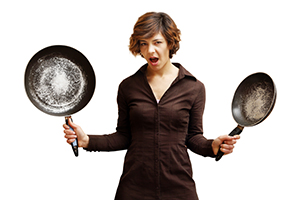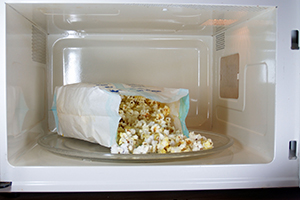
So a few times a year, (yes, it should be more) I tackle the big job of oven cleaning. However, as I open my oven after many months of lots of use, I am more inclined to procrastinate. Many of us have self-cleaning ovens, but wait, what’s that nasty smell that comes with burning throat and itchy eyes that comes with that convenience?

Studies show that Teflon materials when exposed to high temperatures release harmful toxins to babies, children and birds.
Did you know that self-cleaning ovens are lined with Teflon and when exposed to the 600 or more degrees Fahrenheit during cleaning, well, the off-gassing is very toxic to humans, especially babies, young children and pregnant women. The fumes can also cause flu-like symptoms, sweating, coughing and trigger asthma. Pet birds are particularly vulnerable to death in being exposed to these toxic fumes. Is it just the Teflon, and if so what can I do that’s more non-toxic for me and my loved ones? Read on…
Did you also know that carbon monoxide is released into the air during the cleaning cycle since the process is burning off the already baked on, charred food in the bottom of the oven, according to Celia Harsch with Demand Media? So just a quick recap, by turning that self-cleaning oven on you are

The coatings inside popcorn bags contain toxic PFOAs as well.
exposing yourself and those in your home to a group of chemicals called PFOAs. They are known carcinogens and do not flush out of our systems quickly. They are really pretty bad and you really don’t want them in your house. Some of these chemicals are also found in microwavable popcorn bags and non-stick pots and pans. Even with good ventilation, these bad boy chemicals don’t go away easily so I highly recommend replacing anything with this coating. It means a bit more elbow work but it’s healthier.
Why Are Aerosol Oven Cleaners So Unhealthy?
According to the Environmental Working Group, only 1 of 12 standard oven cleaners rated a C, all the others all received totally failing grades. Each of them contained at least one of a number of horribly toxic chemicals, including lye and petroleum distillates like kerosene. (Petroleum distillates are hydrocarbon solvents produced from crude oil.) They can cause serious health issues: burns to the skin, eyes, mouth, throat and even stomach when in direct contact! I used to use those nasty aerosol oven cleaners with toxic chemicals to clean my oven. The directions said to wait a couple hours and wipe down. I did so but then my eyes burned and I was coughing most of the time. Not good.
Here’s the link to the list of oven cleaners with failing grades according to the Environmental Working Group: List of Oven Cleaners

A simple paste of white vinegar and baking soda will leave your oven nice and clean while leaving your kitchen healthy for all.
So how do I Clean my Oven without using Toxic Chemicals?
This will require a little more of your time and effort but in the end it’s so much healthier.
- Sprinkle baking soda on the bottom of your oven followed by enough white vinegar to set the soda bubbling or fizzing.
- Wait 20 minutes then take a good sponge, or stainless steel scouring pads and start scrubbing.
To make things even easier, let the mixture sit 12 hours or overnight. A damp dishcloth and plastic spatula can also help scrape off the paste. Oh, and don’t forget to wear a good pair of rubber gloves to protect your nails.
For cleaning the racks, I let one half of the racks soak in the sink in hot water and organic dish-washing soap for a few hours. Before going to bed, I flip them and let the other half soak.

Don’t forget to wear rubber gloves to protect your hands and nails.
Yes, a little more time and effort but I think most of you will agree that it’s a healthier option for you and your loved ones. Trust me, there’s something kind of rewarding when you wipe that grime off and you’re left with a clean and sparkly oven! And let’s face it, a box of baking soda and some vinegar is pretty inexpensive!
Be Well and Happy Baking!
![]()
Sources:
Accidentally Green
Cecilia Harsch-Demand Media with SF Gate
Mommy Footprint
Environmental Working Group
If you “Like” this post, I’d be thrilled if you’d share it.
NOV
